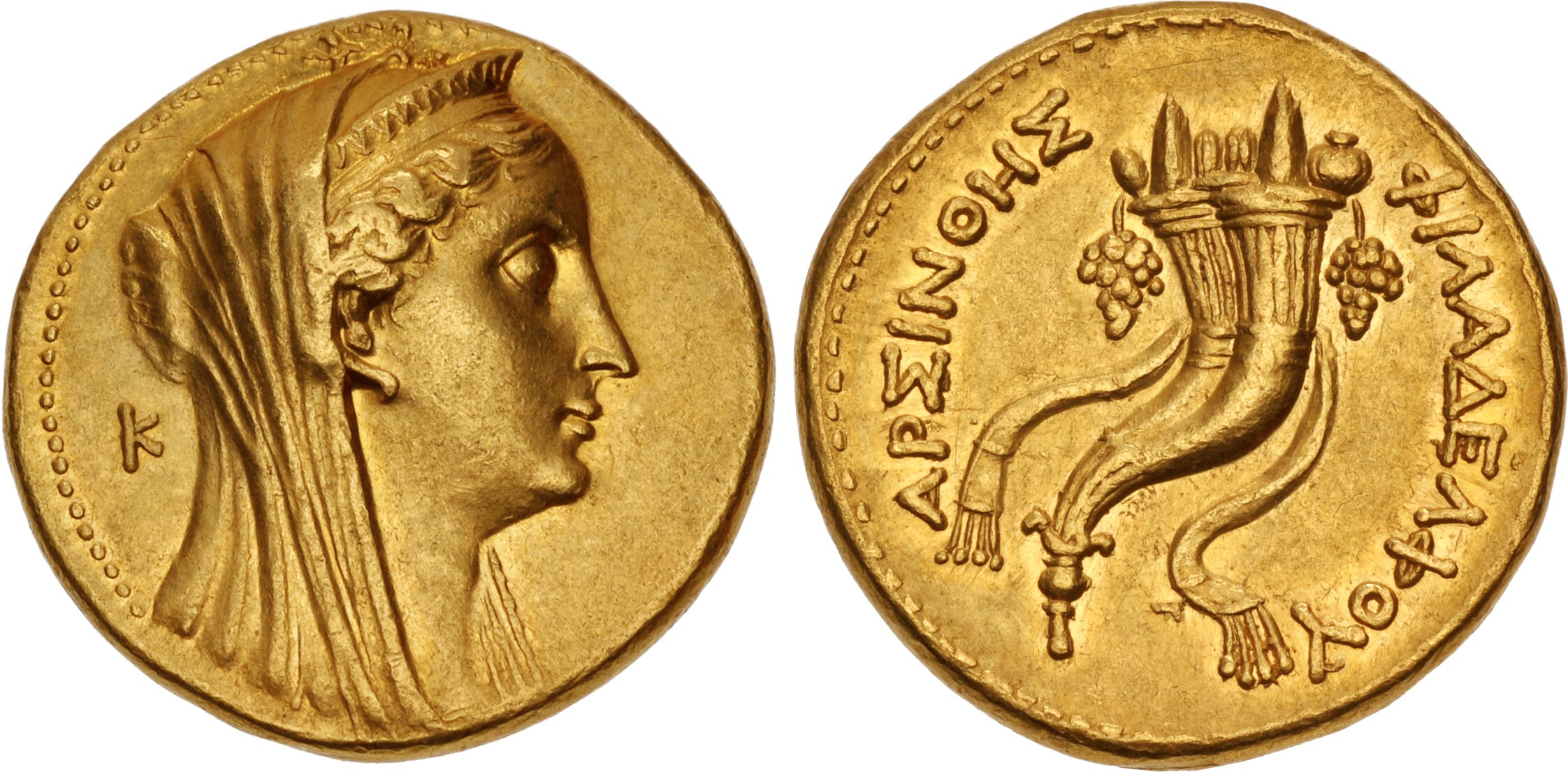S 2064 - Alexandria (Ptolemy II), gold, mnaieia (261-245 BCE)
From SILVER
261 BCE - 245 BCE Gold 92,352 kg
Description
| ObverseInscription or printing placed on the obverse.: | Head right with ram's horn, veiled and wearing stephanos, lotus-tipped scepter in background, K to left |
| ReverseInscription or printing placed on the reverse.: | APΣINOHΣ ΦIΛAΔEΛΦOY (Greek).Double cornucopia, grape bunches hanging at sides, bound with fillet |
Mint and issuing power
| MintIdentifies the place of manufacture or issue of a numismatic object.: | Alexandria | Ancient regionAncient region.: | Egypt | Modern countryModern country: Egypt | AuthorityIdentifies the issuing power. The authority can be "pretended" when the name or the portrait of X is on the coin but he/she was not the issuing power. It can also be "uncertain" when there is no mention of X on the coin but he/she was the issuing power according to the historical sources: | Arsinoe II (queen of Thrace, Asia Minor and Macedonia, Ptolemaic queen and co-ruler of Egypt, c. 300-c. 270 BC), Ptolemaic dynasty (323-30 BC), Ptolemy II Philadelphus (Ptolemaic king, 283-246 BC) |
Chronology
| FromIdentifies the initial date in a range assigned in a numismatic context. | 261 BCE | toIdentifies the final date in a range assigned in a numismatic context.. | 245 BCE | PeriodTime period of the numismatic object.: Hellenistic 323-30 BC |
Physical description
| MetalThe physical material (usually metal) from which an object is made.: | Gold |
Median weightMedian of the weights of numismatic objects (in grams). in grams | 27.80 | DenominationTerm indicating the value of a numismatic object. Examples: tetradrachm, chalkous, denarius.: | mnaieion |
StandardStandard.: | Ptolemaic |
Image

S2064 Egypt manieia Arsinoe.jpg [1]
References
| Die study referencePublication of the study: | Troxell 19831Troxell 1983, Olivier - Lorber 20132Olivier - Lorber 2013, p. 89-98, n° 1-314 | ||
| Coin series referenceReference to coin series study: | Sear II3Sear II, n° 7768, CPE I4CPE I, n° 390 | ||
Obverse dies distribution
| FrequencyFrequency of specimen in distribution. ᵖ | Number of obversesNumber of obverse dies. ᵖ (o) | % (o) | Number of coinsNumber of coins. (n) | % (n) | Die nameName(s) of the die(s). |
| 1 | 6 | 35.29 | 6 | 1.91 | 1, 2, A1, I1, N1, O1 |
| 2 | 1 | 5.88 | 2 | 0.64 | D1 |
| 3 | 1 | 5.88 | 3 | 0.96 | Z1 |
| 4 | 1 | 5.88 | 4 | 1.27 | E1 |
| 5 | 1 | 5.88 | 5 | 1.59 | M1 |
| 9 | 2 | 11.76 | 18 | 5.73 | 3, H1 |
| 17 | 1 | 5.88 | 17 | 5.41 | X1 |
| 28 | 1 | 5.88 | 28 | 8.92 | I2 |
| 40 | 1 | 5.88 | 40 | 12.74 | L1 |
| 80 | 1 | 5.88 | 80 | 25.48 | K1 |
| 111 | 1 | 5.88 | 111 | 35.35 | TH1 |
| Total | 17 of 17 | 99.97 | 314 of 314 | 100 |
Reverse dies distribution
no distribution is available
Quantification
| Number of obversesNumber of obverse dies. ᵖ (o) | 17 | Number of singletons (o1)The number of singleton coins. ᵖ | 6 |
| Number of reverse diesNumber of reverse dies. (r) | 110 | Number of coinsNumber of coins. (n) | 314 |
| Coins per obverse dieNumber of coins per obverse die. (n/o) | 18.47 | Coins per reverse dieNumber of coins per reverse die. (n/r) | 2.85 |
| Reverse per obverse ratioRatio of obverse dies divided by reverse dies. (r/o) | 6.47 | Percentage of singletons (o1)number of coins (n) divided by the number of singletons (o1) ᵖ | 35.29 % |
| Original number of dies (O) (Carter 1983 formula)The estimation of the number of coins according to Carter 1983 ᵖ | 16.61 | Coins struck if 20,000 as average productivity per dieCoins made if the average productivity for obverses (according to Carter) is 20,000. ᵖ | 332,200 |
| Original number of dies (O) (Esty 2011 formula)The estimation of the number of coins according to the singleton formula in Esty 2011 ᵖ (O) | 17.97 | Survival rate if 20,000 as average productivity per dieSurvival rate if average productivity is 20,000. ᵖ | 0.00095 |
| Coverage (o = % of O) (Esty 1984 formula)Esty 1984 - coverage (% of O) ᵖ (o = % of O) | 98.09% | Die productivity if survival rate 1/2,000Average productivity if survival rate is 1/2,000. ᵖ | 37,808.55 |
| Weight of silver (in kg) if 20,000 coins per die (O = Carter formula)Carter 1983 * Median weight * 20000 (*10 if gold or electrum) ᵖ | 92,352 kg <br /> 92,352 kg | Die productivity if survival rate 1/5,000Average productivity if survival rate is 1/5,000. ᵖ | 94,521.37 |
Remarks
Most likely one single workstation Troxell 1983: 131 coins for 16 obv. and 79 rev.; obv. TH1 (year 9 = theta) is associated to 34 reverse dies; Obv. K1 to 24 reverse dies.
References
- ^ Troxell, Hyla A. (1983), "Arsinoe's Non-Era", American Numismatic Society. Museum Notes, 28, p. 35-70
- ^ Olivier, Julien - Lorber, Catharine C. (2013), "Three gold coinages of third-century Ptolemaic Egypt," Revue belge de Numismatique, 159, p. 49-150.
- ^ Sear, David R. (1979), Greek coins and their values. Vol. II, Asia and North Africa, London, xlviii, p. 317-762
- ^ Lorber, Catharine C. (2018), Coins of the Ptolemaic empire : Part I. Ptolemy I through Ptolemy IV, 2 vol., New York.